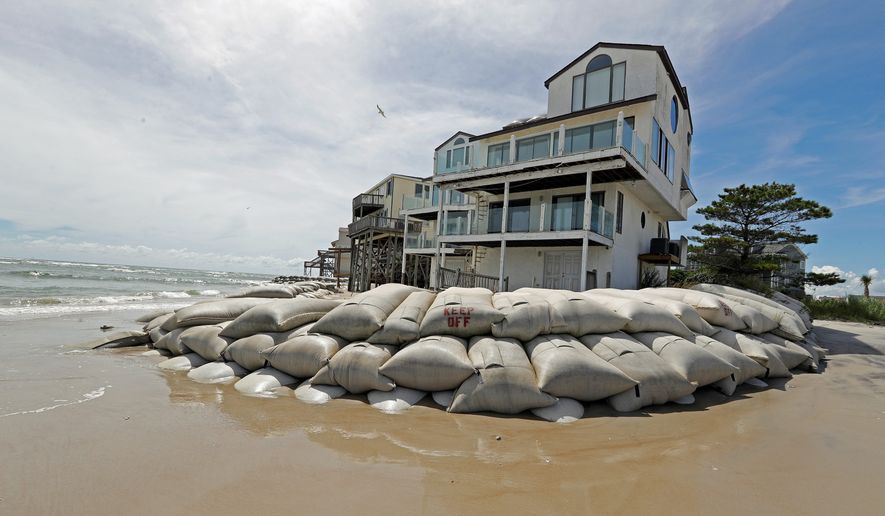The National Weather Service on Wednesday warned that Hurricane Florence could create “life-threatening conditions,” as the massive storm weakened to a Category 3 gale packing 120 mph winds on a collision course with the Carolinas.
“There’s no other way to say this: This storm, as large as it is, and the way it’s been bearing down, we do think that life-threatening conditions are likely,” said Steve Pfaff, a National Weather Service meteorologist in North Carolina.
The National Hurricane Center and the National Weather Service predict Florence will likely weaken further when it hits the Carolinas as early as Friday afternoon, but it will create conditions for catastrophic flooding with as much as 35 inches of rain.
“There are a lot of areas that have never seen flooding are going to experience it,” Mr. Pfaff said. “Thirty-five inches [of rain] means low bridges, roads will fail, sinkholes will form, many structures over widespread areas will be flooded.”
As of 6 p.m. Wednesday, the hurricane was 500 miles across and growing in size, if not strength.
“The size of it now — the cloud field — would encompass all of North and South Carolina,” the meteorologist said.
Thousands of coastal residents in North and South Carolina emptied gas stations and stores Wednesday as they evacuated ahead of the storm, and the Navy moved its ships and personnel away from Virginia’s coast as Florence approached.
“Get out of the way of it,” President Trump said in a video address Wednesday. “Don’t play games with it. It’s a big one.”
The president said Tuesday that the federal government is “totally prepared” for the hurricane, and administration officials on Wednesday pushed back against criticism over the transfer of $10 million from the Federal Emergency Management Agency to Immigration and Customs Enforcement.
“Under no circumstances was any disaster-relief funding transferred from FEMA to [ICE],” said Tyler Houlton, a spokesman for the Department of Homeland Security, which oversees both agencies. “This is a sorry attempt to push a false agenda at a time when the administration is focused on assisting millions on the East Coast facing a catastrophic disaster.”
Homeland Security is authorized to shift money in its $15 billion between its components, which include ICE and FEMA.
Sen. Jeff Merkley, Oregon Democrat, cited an Aug. 31 DHS report in criticizing the department for the transfer of funds.
The president on Tuesday directed FEMA to assist the governors of North and South Carolina, Virginia and Maryland, all of whom have declared state of emergency. Mandatory evacuations of nearly 2 million coastal residents in the Carolinas and Virginia continued Wednesday.
The American Red Cross said Wednesday it has sent 1,500 disaster workers to the area equipped with 80 emergency response vehicles and 120 trailers of supplies.
Thousands of utility linemen and National Guardsmen from across the country also have been deployed to assist with hurricane preparation, rescue and clean-up.
The Waffle House, a Georgia-based fast-food chain, is often known as a litmus test for how bad a storm is because the 24/7 restaurants usually remain open no matter the disaster. On Wednesday the company activated its emergency storm watcher team, which previously FEMA has said it closely monitors.
The governors of North and South Carolina and Virginia urged evacuees to bring emergency kits to the shelters.
“We can’t expect this storm to blow over in a matter of hours. Remember you need to have enough supplies for several days,” North Carolina Gov. Roy Cooper said Wednesday.
“We encourage citizens to seek shelter first with friends and family, to consider hotels outside of evacuation areas, and then look to local shelters, and lastly to state shelters,” Virginia Gov. Ralph Northam said Wednesday.
Mr. Northam opened two state-run shelters at Christopher Newport University and the College of William and Mary, which will coordinate with 24 other, locally-run shelters across the commonwealth.
No shelters require identification or proof of residency. Service animals are allowed, but not all shelters allow pets. People are encouraged to call state helplines for information about the shelters near them.
Meanwhile, the military is evacuating several of bases across the region, including the Marine Corps’ Parris Island in South Carolina and Camp Lejeune in North Carolina, the Army’s Fort Bragg, in North Carolina, and the Air Force’s Joint Base Langley-Eustis in Virginia.
• This article is based in part on wire service reports.
• Julia Airey can be reached at jairey@washingtontimes.com.




Please read our comment policy before commenting.